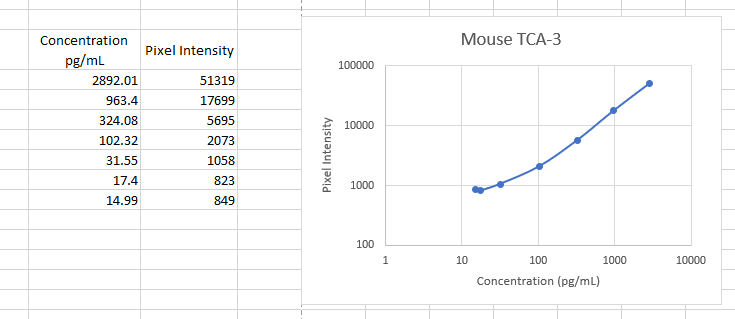Mouse CCL1/I‑309/TCA‑3 Biotinylated Antibody Summary
Lys24-Cys92
Accession # P10146
Applications
Mouse CCL1/TCA-3 Sandwich Immunoassay
Please Note: Optimal dilutions should be determined by each laboratory for each application. General Protocols are available in the Technical Information section on our website.
Reconstitution Calculator
Preparation and Storage
- 12 months from date of receipt, -20 to -70 °C as supplied.
- 1 month, 2 to 8 °C under sterile conditions after reconstitution.
- 6 months, -20 to -70 °C under sterile conditions after reconstitution.
Background: CCL1/I-309/TCA-3
Mouse TCA-3 is a member of the CC beta family of chemokines. The human chemokine I-309, which shares approximately 42% amino acid (aa) sequence identity, has been assumed to be the homologue of mouse TCA-3. Mouse TCA-3 and human I-309 also share significant sequence homology in the 5' flanking region of their genes and each contain an extra pair of cysteine residues not found in most other chemokines.
TCA-3 cDNA encodes a 92 aa residue precursor protein with a predicted 23 aa signal peptide that is cleaved to produce a 69 aa mature protein. The sequence of TCA-3 contains one potential N-linked glycosylation site. Mouse TCA-3 is found on the distal portion of mouse chromosome 11 in a cluster with MIP-1 alpha, MIP-1 beta, and JE. TCA‑3 acts by binding to the seven transmembrane spanning G-protein-coupled receptor, CCR8. TCA-3 has been shown to chemoattract T-cells.
- Goya, I. et al. (1998) J. Immunol. 160:1975.
- Burd, P. et al. (1987) J. Immunol. 139:3126.
Product Datasheets
Citations for Mouse CCL1/I‑309/TCA‑3 Biotinylated Antibody
R&D Systems personnel manually curate a database that contains references using R&D Systems products. The data collected includes not only links to publications in PubMed, but also provides information about sample types, species, and experimental conditions.
5
Citations: Showing 1 - 5
Filter your results:
Filter by:
-
The chemokine receptor CCR8 promotes the migration of dendritic cells into the lymph node parenchyma to initiate the allergic immune response.
Authors: Caroline L. Sokol, Ryan B. Camire, Michael C. Jones, Andrew D. Luster
Immunity
-
Response patterns of cytokines/chemokines in two murine strains after irradiation.
Authors: Zhang M, Yin L, Zhang K, Sun W, Yang S, Zhang B, Salzman P, Wang W, Liu C, Vidyasagar S, Zhang L, Ju S, Okunieff P, Zhang L
Cytokine, 2012-01-25;58(2):169-77.
Species: Mouse
Sample Types: Plasma
Applications: Luminex Development -
Resolution of allergic inflammation and airway hyperreactivity is dependent upon disruption of the T1/ST2-IL-33 pathway.
Authors: Kearley J, Buckland KF, Mathie SA, Lloyd CM
Am. J. Respir. Crit. Care Med., 2009-01-29;179(9):772-81.
Species: Mouse
Sample Types: Cell Culture Supernates
Applications: ELISA Development -
CD4+CD25+ regulatory T cells reverse established allergic airway inflammation and prevent airway remodeling.
Authors: Kearley J, Robinson DS, Lloyd CM
J. Allergy Clin. Immunol., 2008-07-30;122(3):617-24.e6.
Species: Mouse
Sample Types: BALF
Applications: ELISA Development -
Synthesis of several chemokines but few cytokines by primed uncommitted precursor CD4 T cells suggests that these cells recruit other immune cells without exerting direct effector functions.
Authors: Mosmann T
Eur. J. Immunol., 2004-06-01;34(6):1617-26.
Species: Mouse
Sample Types: Cell Culture Supernates
Applications: ELISA Development
FAQs
No product specific FAQs exist for this product, however you may
View all Antibody FAQsReviews for Mouse CCL1/I‑309/TCA‑3 Biotinylated Antibody
Average Rating: 4.5 (Based on 2 Reviews)
Have you used Mouse CCL1/I‑309/TCA‑3 Biotinylated Antibody?
Submit a review and receive an Amazon gift card.
$25/€18/£15/$25CAN/¥75 Yuan/¥2500 Yen for a review with an image
$10/€7/£6/$10 CAD/¥70 Yuan/¥1110 Yen for a review without an image
Filter by:
Used as ELISA detection




